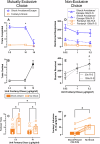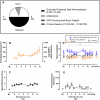Effects of pharmacological and environmental manipulations on choice between fentanyl and shock avoidance/escape in male and female rats under mutually exclusive and non-exclusive choice conditions
- PMID: 39103498
- PMCID: PMC11480371
- DOI: 10.1038/s41386-024-01939-7
Effects of pharmacological and environmental manipulations on choice between fentanyl and shock avoidance/escape in male and female rats under mutually exclusive and non-exclusive choice conditions
Abstract
Substance use disorders are defined by persistent drug consumption despite adverse consequences. Accordingly, we developed two fentanyl-vs-shock avoidance/escape choice procedures in which male and female rats responded under a fixed-ratio (FR)1:FR1 concurrent schedule of shock avoidance/escape and IV fentanyl under either mutually exclusive or non-exclusive choice conditions. Initial experiments using a discrete-trial procedure determined behavioral allocation between mutually exclusive shock avoidance/escape and different fentanyl doses (0.32-18 μg/kg/infusion; Experiment 1). Shock intensity (0.1-0.7 mA) and shock avoidance/escape response requirement (FR1-16) were also manipulated (Experiment 2). Next, we used a free-operant procedure in which shock avoidance/escape and fentanyl were continuously available under non-exclusive conditions, and response-shock (R-S) interval (30-1000 s) was manipulated (Experiment 3). Finally, we tested the hypothesis that extended-access fentanyl self-administration would produce fentanyl dependence, establish fentanyl withdrawal as an endogenous negative reinforcer, and increase fentanyl choice in both procedures (Experiments 4 and 5). The shock avoidance/escape contingency decreased fentanyl self-administration, and rats consistently chose shock avoidance/escape over fentanyl in both choice conditions. Decreasing shock intensity or increasing shock avoidance/escape response requirement failed to increase fentanyl choice, suggesting that fentanyl and shock avoidance/escape are independent economic commodities. Increasing the R-S interval increased fentanyl choice but failed to increase shock delivery. Extended fentanyl access engendered high fentanyl intake and opioid withdrawal signs but failed to increase fentanyl choice under either choice condition. These results suggest that neither positive fentanyl reinforcement nor negative reinforcement by fentanyl withdrawal is sufficient to reduce shock avoidance/escape-maintained responding and increase foot shock as an adverse consequence.
© 2024. The Author(s).
Conflict of interest statement
The authors declare no competing interests.
Figures





Similar articles
-
Effects of environmental and pharmacological manipulations on cocaine-vs-negative reinforcer choice in male and female rats.Psychopharmacology (Berl). 2023 Aug;240(8):1677-1689. doi: 10.1007/s00213-023-06404-9. Epub 2023 Jun 20. Psychopharmacology (Berl). 2023. PMID: 37340053 Free PMC article.
-
Lack of effect of different pain-related manipulations on opioid self-administration, reinstatement of opioid seeking, and opioid choice in rats.Psychopharmacology (Berl). 2021 Jul;238(7):1885-1897. doi: 10.1007/s00213-021-05816-9. Epub 2021 Mar 25. Psychopharmacology (Berl). 2021. PMID: 33765177 Free PMC article.
-
Conjugate vaccine produces long-lasting attenuation of fentanyl vs. food choice and blocks expression of opioid withdrawal-induced increases in fentanyl choice in rats.Neuropsychopharmacology. 2019 Sep;44(10):1681-1689. doi: 10.1038/s41386-019-0385-9. Epub 2019 May 2. Neuropsychopharmacology. 2019. PMID: 31043682 Free PMC article.
-
Sex differences in opioid reinforcement under a fentanyl vs. food choice procedure in rats.Neuropsychopharmacology. 2019 Nov;44(12):2022-2029. doi: 10.1038/s41386-019-0356-1. Epub 2019 Feb 28. Neuropsychopharmacology. 2019. PMID: 30818323 Free PMC article.
-
Sensitivity of a fentanyl-vs.-social interaction choice procedure to environmental and pharmacological manipulations.Pharmacol Biochem Behav. 2022 Nov;221:173473. doi: 10.1016/j.pbb.2022.173473. Epub 2022 Oct 10. Pharmacol Biochem Behav. 2022. PMID: 36228740 Free PMC article.
Cited by
-
Mechanistic and translational insights from preclinical cocaine choice procedures on the economic substitutability of cocaine and nondrug reinforcers.Neurosci Biobehav Rev. 2025 Aug;175:106217. doi: 10.1016/j.neubiorev.2025.106217. Epub 2025 May 21. Neurosci Biobehav Rev. 2025. PMID: 40409443 Review.
-
A Review of Behavioral Economic Manipulations Affecting Drug versus Nondrug Choice in Rats.Perspect Behav Sci. 2025 Apr 7;48(2):341-366. doi: 10.1007/s40614-025-00445-5. eCollection 2025 Jun. Perspect Behav Sci. 2025. PMID: 40520583 Free PMC article. Review.
-
Demand for heroin in rats: effects of non-drug alternative substitutes and complements.Neuropsychopharmacology. 2025 May 9. doi: 10.1038/s41386-025-02127-x. Online ahead of print. Neuropsychopharmacology. 2025. PMID: 40346179
References
-
- Engeln M, Ahmed SH. The multiple faces of footshock punishment in animal research on addiction. Neurobiol Learn Mem. 2024;213:107955. - PubMed
-
- Grove RN, Schuster CR. Suppression of cocaine self-administration by extinction and punishment. Pharm Biochem Behav. 1974;2:199–208. - PubMed
-
- Bergman J, Johanson CE. The effects of electric shock on responding maintained by cocaine in rhesus monkeys. Pharm Biochem Behav. 1981;14:423–26. - PubMed
MeSH terms
Substances
Grants and funding
- T32 DA007027/DA/NIDA NIH HHS/United States
- T32DA007027/U.S. Department of Health & Human Services | NIH | National Institute on Drug Abuse (NIDA)
- R21DA053820/U.S. Department of Health & Human Services | NIH | National Institute on Drug Abuse (NIDA)
- F31DA059209/U.S. Department of Health & Human Services | NIH | National Institute on Drug Abuse (NIDA)
LinkOut - more resources
Full Text Sources

